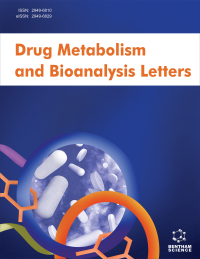- Home
- A-Z Publications
- Drug Metabolism and Bioanalysis Letters
- Previous Issues
- Volume 15, Issue 1, 2022
Drug Metabolism and Bioanalysis Letters - Volume 15, Issue 1, 2022
Volume 15, Issue 1, 2022
-
-
Medicinal Importance, Pharmacological Activities and Analytical Aspects of a Flavonoid Glycoside ‘Nicotiflorin’ in the Medicine
More LessBackground: Herbal products are derived from different natural sources, mainly used as a source of food material and medicine in the health sectors since ancient times. Herbal products have gained popularity in modern medicine due to their beneficial health properties and pharmacological activities. Flavonoids are an important class of secondary metabolites found to be present in medicinal plants and their Read More
-
-
-
Practical Application of Rodent Transporter Knockout Models to Assess Brain Penetration in Drug Discovery
More LessBackground and Objective: Compound X is a drug candidate for the treatment of neurodegenerative diseases. Its brain distribution was evaluated as part of the lead identification and optimization activities undertaken in early drug discovery. Methods: The brain distribution of compound X was studied in genetic transporter knockout rodent models, in vivo models with a chemical inhibitor, and in vitro transporter cell systems. Re Read More
-
-
-
Characterization of Human-malarial Parasite Species based on DHFR and GST Targets Resulting in Changes in Anti-malarial Drug Binding Conformations
More LessAuthors: Shrutika Sakpal, Shanker L. Kothari and Virupaksha BastikarBackground: In this study, we focused primarily on three anti-malarial drugs, namely chloroquine, mefloquine, and proguanil, and these were tested against two malarial targets DHFR and GST. The species Plasmodium falciparum, Plasmodium malariae, Plasmodium ovale, Plasmodium vivax were used for the study. Objective: The purpose of this study was to determine the sequence and structural similarity of the protei Read More
-
-
-
Investigation of Human in vivo Metabolism of SEP-227900 Using the Samples from First-in-Human Study by LC-HRMS/UV and NMR
More LessAuthors: Yu-Luan Chen, Estela Skende, Armand Gatien N. Wetie and Peter Li-Quan WangObjective: The study aims to explore the human in vivo metabolism of SEP-227900 (4H-furo[3, 2-b] pyrrole-carboxylic acid, m.w 151.03), a D-amino-acid oxidase (DAAO) inhibitor, by using plasma and urine samples from first-in-human study. Methods: The human plasma and urine samples were from a single dose cohort that consisted of 9 healthy male volunteers each received an 80- mg dose of SEP-227900 orally. The poo Read More
-
-
-
Role of P34S, G169R, R296C, and S486T Substitutions in Ligand Access and Catalysis for Cytochrome P450 2D6 Allelic Variants CYP2D6*14A and CYP2D6*14B
More LessAuthors: Amelia N. Dong, Nafees Ahemad, Yan Pan, Uma Devi Palanisamy, Beow Chin Yiap and Chin Eng OngBackground: Genetic polymorphism of cytochrome P450 (CYP) contributes to variability in drug metabolism, clearance, and response. This study aimed to investigate the functional and molecular basis for altered ligand binding and catalysis in CYP2D6*14A and CYP2D6*14B, two unique alleles common in the Asian population. Methods: CYP proteins expressed in Escherichia coli were studied using the substrate 3-cyano-7- ethox Read More
-
-
-
Plasma Concentration Profiles for Hepatotoxic Pyrrolizidine Alkaloid Senkirkine in Humans Extrapolated from Rat Data Sets Using a Simplified Physiologically Based Pharmacokinetic Model
More LessAuthors: Yusuke Kamiya, Tomonori Miura, Airi Kato, Norie Murayama, Makiko Shimizu and Hiroshi YamazakiAim: The main aim of the current study was to obtain forward dosimetry assessments of pyrrolizidine alkaloid senkirkine plasma and liver concentrations by setting up a human physiologically based pharmacokinetic (PBPK) model based on the limited information available. Background: The risks associated with plant-derived pyrrolizidine alkaloids as natural toxins have been assessed. Objective: The pyrrolizidine alkaloid Read More
-
Most Read This Month
Article
content/journals/dmbl
Journal
10
5
false
en


